“The worship of God means absolute devotion to Him and the exact execution of His commands, whether or not one understands the meaning or purpose of it.”
Foreword:
From a physiological point of view, we can consider the prescribed daily five prayers in Islam as athletic movements with a health-promoting and pain-relieving effect on the whole body, especially on the locomotor system. I think that as long as the vital locomotor system is healthy and functional, you remain always active, and you can continue your own life independently without the help of others throughout your life. This keeps people mentally in a good and happy mood. We should also mention that the movements during prayer, among other things, promote the bloodstream so that now all the cells in the body are supplied with enough blood and oxygen, that they all constantly perform their function well. This is especially true for brain cells. They do not become atrophic, so they do not degrade and stay functional until the end of life. This is the best-known method of prevention against one of the worst diseases in old age: Alzheimer’s disease [1].
God says in the Quran, in Chapter 16 -An-Nahl, the Bee, verse 70, the following:
وَاللَّهُ خَلَقَكُمْ ثُمَّ يَتَوَفَّاكُمْ وَمِنْكُمْ مَنْ يُرَدُّ إِلَى أَرْذَلِ الْعُمُرِ لِكَيْ لَا يَعْلَمَ بَعْدَ عِلْمٍ شَيْئًا إِنَّ اللَّهَ عَلِيمٌ قَدِيرٌ
“God created you, then He will cause you to die. He lets some of you live till the most despicable time of his life that he no longer knows what he used to know [2]. God knows and establishes criteria [3].“
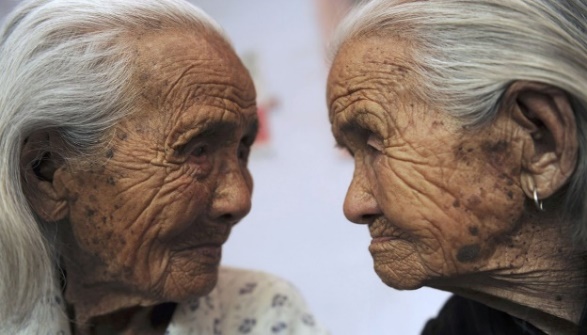
All scientific studies confirm that life means movement, and movement means life. We can almost say that when God prescribed the five prayers at the time of Muhammad (pbuh), He prescribed them to only keep the system of motion so healthy and motile for life. Just consider what psychosomatic agony one would have in cases of painful joint disorders and the inability to move (with joint stiffening). The performance of the daily prayers is thus beneficial on both sides: the later, otherworldly reward for it, and the present, this world-wide high health benefit.
This is actually a fundamental principle in all arrangements in Islam: the double advantages of a single action, namely: Later rewarding on the other side, this present-day benefit.
God says in Chapter 51: Adh-Dhariat, verse 49:
ومن كل شيء خلقنا زوجين لعلكم تذكرون (49) سورة الذاريات (15)
“And of all beings we have created a couple; so that you may use your information.”
The Topic:
Introduction to the Movement System:
The human (1) as an individual consists of several systems. The so-called movement system is one of them. It consists roughly of the bony skeleton (2), which determines the external typical manifestation of man, carries his weight and protects the internal organs. It also consists of the joints, the so-called movement axes, with their ligaments, which offer the general cohesion, as well as of the various muscles (3) with their tendons, which represent the motor. To perform its function, a sufficient blood supply (4), such as own nerve conduction system (5) is required.

So if the movement system is healthy and active, then the whole person is healthy and completely happy. It is of course of the desired things in this life that man remains healthy physically and mentally even in old age. It is so depressing, devastating and degrading that one is left dependent on the help of others for the rest of his life, due to his old age and his physical incapacity. This is a kind of divine punishment for man. I see in Islamic prayer a very good practical method and guarantee, as well as safe prevention for the permanent and lifelong preservation of mental and physical health for each person. It is worth noting that our joints, consisting of bones and cartilage will ever renew their youth and activity, the more they are moved and burdened. In contrast, the artificial joints, or any handmade or artificially manufactured pieces of use have a fixed age, even under the best maintenance conditions. This age is reached faster with constant use.
The Muslim starts praying at a young age to get used to it and then performs that prayer all his life, five times a day. This means that his natural joints remain young and able to move as long as he lives. Obviously, God only wants good for us, even if we do not see it or do not feel it. God says in chapter 7-al-A’raf, verse 157:
يأمرهم بالمعروف وينهاهم عن المنكر ويحل لهم الطيبات ويحرم عليهم الخبائث ويضع عنهم إصرهم والأغلال التى كانت عليهم. سورة الاعراف (7), الآية: 157
“He will enjoin on them that which is right and forbid them that which is wrong. He will make lawful for them all good things and forbids them only from the foul; and he will relieve them of their burden and the fetters they used to wear.”
We thank God for that!
Prayer in Islam
I recommend that you read the text at the following link [7], for a better understanding of this report.
God mentioned the prayers in three different verses in the Qur’an:
1) Chapter 2 – The Cow: Al-Baqara- verse 43:
وأقيموا الصلاة وآتوا الزكاة واركعوا مع الراكعين (سورة البقرة (2) الاية 43)
“And perform the prayer (salaat), give the alms tax (zakaat) and take part (in worship) in the bowing”!
2) Chapter 4 – The Women: An-Nisa, Verse 103:
فإذا قضيتم الصلاة فاذكروا الله قياما وقعودا وعلى جنوبكم فإذا أطمأننتم فأقيموا الصلاة إن الصلاة كانت على المؤمنين كتابا موقوتا. سورة النساء (4) الاية (103)
“When you offer the prayer (in shortened form), commemorate God standing and sitting and on your sides. When you are secure, offer the prayer duly (as usual), because the prayer has been prescribed to the believers as linked to particular times.”
3) Chapter 22 – The Pilgrimage: Al-Haj, verse 77:
يا أيها الذين آمنوا اركعوا واسجدوا واعبدوا ربكم وافعلوا الخير لعلكم تفلحون (سورة الحج (22), الاية 77
“Believers! Bow down (at worship), prostrate (in worship), serve your Master and do good! Maybe it will (then) fare well for you. “[10]
These three listed verses from the Qur’an explain how the prayer should basically be performed:
It, therefore, consists of the following:
Standing up for prayer and first of all addressing the Qibla [11], the announcement that one now wishes to begin prayer by raising both hands to the ears, bowing, prostration “on the sides” of oneself and sitting in between and the announcement at the end of the prayer that one has now finished by turning the head to the right and to the left. This is one unit (Rakaa) of prayer (Salaat). Usually, a prayer consists of several units, at least two and at most four similar units. Only the announcement of the beginning and the end of the prayer should be given once for each complete prayer.
These different movements are the content of our topic.
Many scientific and physiotherapeutic studies [12] have found that all movements during Islamic prayer are very useful to the body. For example, the ligaments and tendons are stretched, reinforcing the musculature and constantly moving the joints, alleviating joint pain. By actively promoting circulation during prayer, the blood supply is significantly improved, in addition to speeding up the removal of accumulated metabolic waste products from the blood and tissues.
It is an easily noticed fact that the performance of God’s orders in Islam has two advantages in general: Of course, the otherworldly reward of God on the Day of Resurrection, and the immediate benefits that one has now, in this life of the world. God says in chapter 51 – The Scatterers, verse 49:
ومن كل شيء خلقنا ز وجين لعلكم تذكرون (49), سورة الذاريات 51
And of all we have created a couple; so that you may use your information. [13]
Now we study these ritual movements in detail:
1st: Directing Oneself Towards the Qibla [14].
If you want to offer the prayers in Islam, then you have to stand up and direct yourself to Qibla, to the region of the Sacred Mosque (al-Masjid al-Haram) in Mecca. Kaba is the very first house of worship on earth that lies inside the region of the Sacred Mosque.

So you read in chapter 3 – The House of Imran, verse 96:
إن أول بيت وضع للناس للذي ببكة مباركا وهدى للعالمين (96) سورة آل عمران (3).
“The very first house of worship (Kaba) that has been established for man is that in Bakka [16] (Mecca), (established) for the blessing and guidance of people throughout the world (al-‘Aaalameen)” ]
When Abraham received the order to build Kaba from God, it was a rebuilding:
God says in chapter 2 – The Cow: Al-Bakara, verse 127:
وإذ يرفع إبراهيم القواعد من البيت وإسماعيل ربنا تقبل منا إنك أنت السميع العليم (127), سورة البقرة (2)
“And when Abraham rebuilt the foundations of the house (the Ka`ba): (يرفع), (he) and Ishmael (and prayed to Allah):” “Our Master! Accept (this) from us! You are the one who hears (all) and knows. “[18]
The so-called Black Stone, which is located in the southeastern outer corner of Kaba, is nothing but a remnant of the ancient wall of the Kaba, which was most likely first built by Adam. After all, the very first house of God fits the very first man on earth.

The mountains around Kaba inside Mecca are interestingly black. God says in chapter 35 – The Creator Verse 27:
ألم تر أن الله أنزل من السماء ماء فأخرجنا به ثمرات مختلفا ألوانها ومن الجبال جدد بيض وحمر مختلف ألوانها وغرابيب سود (27), سورة فاطر
“Did not you see that Allah made water come down from heaven? And we have thereby produced fruits of various kinds. Even mountains have different layers and colors: white, red and coal black (gharaabibu suudun). “[20]
In all Arabic lexicons (There are about 23 lexicon), the Arabic word: gharaabib: غرابيب interpreted as dark black. For those who are interested, the following example is presented as an explanation from the lexicon of Arabic Modern Language, Chapter 3542, Section 2, page 1603:
{وَمِنَ الْجِبَالِ جُدَدٌ بِيضٌ وَحُمْرٌ مُخْتَلِفٌ أَلْوَانُهَا وَغَرَابِيبُ سُودٌ}:
غِرْبيب [مفرد]: ج غرابيبُ: شديد السَّواد، وغالبًا ما يأتي توكيدًا فيقال: أسودُ غربيبٌ „أسود غِرْبيب: حالِك- „.
Adam, since God had taught him everything, mastered the art of cutting out of geometrically cut blocks from the “black” mountains of Mekka, and then used them for the construction of the very first mosque (Kaba) in Mecca. It would have to be so that the current clothing of the Kaba is perhaps black because of the original black blocks. So Kaba originally looked black. The teacher of Adam was and is Allah. He taught him all the names. God says in chapter 2 – The Cow, verse 31:
وَعَلَّمَ آدَمَ الْأَسْمَاءَ كُلَّهَا ثُمَّ عَرَضَهُمْ عَلَى الْمَلَائِكَةِ فَقَالَ أَنْبِئُونِي بِأَسْمَاءِ هَؤُلَاءِ إِنْ كُنْتُمْ صَادِقِينَ (31) سورة البقرة
“And he taught Adam all the names. Then he presented them to the angels and said, “Make known their names, if (otherwise) you tell the truth!” “.” [21]
“All names” would have to have very great meaning: It should actually mean that Adam knows everything by name. This also means that every naturally occurring or artificially created thing, every object and just everything in this life has a name, even if we do not know it.
The word Adam in the mentioned verse can be called Adam himself. But it may also mean (and it must also mean so!) that Adam also refers to his offspring, that is, every human being on earth and over all times, up to the day of the resurrection.
On the other hand, the first section of the same verse means: He taught that God is actually the teacher of all sciences and new discoveries through time, as long as there are any. I believe that it is through the teaching (inspiration) of God whenever you discover, invent or create something new in our modern day life.
The word “name” in the mentioned verse also means “well known”. Something whose name you know means that you know everything about it. So we know its function, its nature, its meaning and purpose, its use and so on.
So the verse points to a dynamic, continuous and lifelong action as long as people live on earth.
Knowing all names is a true and never-ending science. It is a constantly progressive, endlessly developing thing. To this day, humanity has only been able to acquire a tiny portion of the knowledge of Adam under the permission of God. For the teacher of Adam and the whole world was, is and remains God Himself, the omniscient.
There are many verses in the Qur’an that suggest that the Saudi city Mecca, and in the city specifically Al-Kaba, House of God (Beitullah) is not only the center of the earth, but also of the entire universe:
1) Chapter 2 – al-Baqarah, Verse 144:
قَدْ نَرَى تَقَلُّبَ وَجْهِكَ فِي السَّمَاءِ فَلَنُوَلِّيَنَّكَ قِبْلَةً تَرْضَاهَا فَوَلِّ وَجْهَكَ شَطْرَ الْمَسْجِدِ الْحَرَامِ وَحَيْثُ مَا كُنْتُمْ فَوَلُّوا وُجُوهَكُمْ شَطْرَهُ وَإِنَّ الَّذِينَ أُوتُوا الْكِتَابَ لَيَعْلَمُونَ أَنَّهُ الْحَقُّ مِنْ رَبِّهِمْ وَمَا اللَّهُ بِغَافِلٍ عَمَّا يَعْمَلُونَ (144) سورة البقرة
“We see that you are undecided where in the sky you should face (at prayer). Therefore, we want to point you (now) in a direction of prayer that you will like to agree with: turn your face towards the holy place of worship “Kaba” (in Mecca)! And wherever you (believers) are, turn your face in that direction! Those who have received the Scripture know that it is the truth (and) of their Master. And Allah is very careful of what they do “[22].
2) Chapter 3 – Al-e Imran, Verse 96:
إِنَّ أَوَّلَ بَيْتٍ وُضِعَ لِلنَّاسِ لَلَّذِي بِبَكَّةَ مُبَارَكًا وَهُدًى لِلْعَالَمِينَ (96) سورة آل عمران(3).
“The first place of worship (Kaba) that has been established for man is the one in Bakka [23] (Mecca), (established) for the blessing and guidance of the people of all beings.”
3) Chapter 14 – Abraham, Verse 37
رَبَّنَا إِنِّي أَسْكَنْتُ مِنْ ذُرِّيَّتِي بِوَادٍ غَيْرِ ذِي زَرْعٍ عِنْدَ بَيْتِكَ الْمُحَرَّمِ رَبَّنَا لِيُقِيمُوا الصَّلَاةَ فَاجْعَلْ أَفْئِدَةً مِنَ النَّاسِ تَهْوِي إِلَيْهِمْ وَارْزُقْهُمْ مِنَ الثَّمَرَاتِ لَعَلَّهُمْ يَشْكُرُونَ (37)، سورة إبراهيم(14).
“Our Master! I have made people of my offspring to settle in your hallowed house in a valley where no corn is growing, Master, so that they may perform the prayer (salaat). Make the hearts of people lovingly come to them and bring them fruits! Maybe they will be thankful “[25].
4) Chapter 29 – al-Ankabut, Verse 67
أَوَلَمْ يَرَوْا أَنَّا جَعَلْنَا حَرَمًا آمِنًا وَيُتَخَطَّفُ النَّاسُ مِنْ حَوْلِهِمْ أَفَبِالْبَاطِلِ يُؤْمِنُونَ وَبِنِعْمَةِ اللَّهِ يَكْفُرُونَ (67)، سورة العنكبوت(67).
“Did not they see that we (in the area of Mecca) have made a holy district (haram) that is safe while the people around them are (by force) taken away? Do they want to believe in what is vain, and not believe in the grace of Allah? “[26]
5) Chapter 42 – ash-Shura, Verse 144:
وَكَذَلِكَ أَوْحَيْنَا إِلَيْكَ قُرْآنًا عَرَبِيًّا لِتُنْذِرَ أُمَّ الْقُرَى وَمَنْ حَوْلَهَا وَتُنْذِرَ يَوْمَ الْجَمْعِ لَا رَيْبَ فِيهِ فَرِيقٌ فِي الْجَنَّةِ وَفَرِيقٌ فِي السَّعِيرِ (7) سورة الشورى (42).
“And so we have given you an Arabic Koran (as a revelation) to warn the mother of the cities (umm al-quraa) and the people around her, and that you (your compatriots) warn before the day of the congregation (the last day), which is beyond doubt. One part will (eventually) be in Paradise, another in Hellfire “[27].
There is so much is in the Qur’an about the direction to be faced during both obligatory and voluntary prayers in Islam.
What does Science Say about Kaba or Mecca?
Geographically, it is claimed that Mecca is in the middle of the dry surface of the earth. In this regard, I refer to the following link:
https://www.youtube.com/watch?v=t3N9UP_sm80.
We really want to talk about the focus of the earth in relation to Kaba. And explain about the earth magnetism also in relation to Kaba. Also, we would like to think that the Earth’s zero meridian runs through Mecca, not Greenwich in England. We’ll come back to that later, when we collect all the scientifically convincing document. I think we will all have them soon.
Since all the cells of each human being are charged and each cell is a small magnet, then the whole human being is also a big magnet. He has thus a so-called magnetic field. The magnetic field of the heart and the brain can be demonstrated more clearly. Such a magnet is influenced by a larger magnetic field. Here is the discussion about the human magnet under the influence of Earth magnetism.



The human magnet is guided in its orientation, like a magnetic compass needle, by the terrestrial magnetism. This comes to rest when its south pole (with a small declension) points north (which changes over time!) And vice versa.
I refer you to the following link for the general reading:
https://www.vitatec.com/en/essentials/essentials—introduction/essentials-page-3
I believe that if one directs himself to Qibla for prayer, no matter where he stands, then his own physical electromagnet polarizes itself through the earth magnetism.
Every cell in our body contains minerals. They are in the ionized state (ions). The most important are sodium and potassium. The different concentrations of these charged ions inside and outside the cell give rise to cellular electricity.
This electricity is the cause of the so-called magnetism of man.
Put simply, every cell in our body, and especially the cells of the heart and the nervous system, is electrically charged. The positive charge is found on the outer cell wall and the negative charge in the inner cell.

The different concentration of electrolytes outside and inside the cell is the basis of cellular electricity [32].
Without going into the details, this electric charge is immensely important to each cell for its vital function. As long as it is polarized, i.e. in two poles, everything is in order. In case of a disruption to this natural arrangement of cellular electricity, the function of the cell is also disturbed. That’s what we call disease.

The normal function is given with normal electricity [33]

The disease of the cell is the disruption of normal electricity [34]
We know that the electric charge of a cell is affected by a magnetic field. When this cell is in the field of the Earth magnet, the magnetic force provides for the order of cellular electricity and brings it back into the so-called resting potential, which is now required for the regular functioning of each cell. This is what happens, without us noticing it, when you are directed to Qibla. This has an effect that calms, regulates and improves the functioning of the body, especially to the heart.

https://physikblog18.wordpress.com/tag/pole/[35]
The cells of the body are like individual magnets that are not ordered (upper picture). Under an electromagnetic field, they arrange themselves symmetrically (bottom picture). This is how an organ can work normally.
The reason why the small magnets arrange themselves is that they follow the so-called field lines of a larger magnet according to their charge when they are in a magnetic field. As the following picture shows, one can make these field lines of a magnet experimentally vivid if one spreads iron sawdust over a magnet: [36]

In Chapter 13 – Ar-Raad, Verse 28 it is decreed:
الَّذِينَ آمَنُوا وَتَطْمَئِنُّ قُلُوبُهُمْ بِذِكْرِ اللَّهِ أَلَا بِذِكْرِ اللَّهِ تَطْمَئِنُّ الْقُلُوبُ (28)، سورة الرعد(13).
“Those who believe, and whose hearts find rest in the remembrance of Allah – in the remembrance of Allah, the heart finds peace.” [37]
This verse could actually be clarified this way:
The remembrance of Allah means to worship Allah, or to perform the prayer. So it involves having your face and body turn to Kaba. His cells, and of course the cells of his heart and brain, are arranged according to the electromagnetic field lines of the earth (polarization). In this arrangement, the cells are in a rest potential position. This explains the calmness that you feel in your heart and mind. But most of all, it has to do with the energy one feels during prayer. Because the cells that are at rest potential are fully ready for a complete new function. So you feel active and full of energy to do any activity.
So far, I think. But God knows better. He is the Omniscient and Almighty!
2nd: The Announcement of the Beginning of the Prayer.
This is completed, at the beginning of standing for prayer, by loud announcements: “Allah-Hu-Akbar” while touching the earlobes with his thumbs and pointing the palms of the palm forward. Listen to people in the immediate vicinity of a praying person and see that he has started praying. So here we are interested in the arm movement we have made: namely the raising of both arms at the beginning of the prayer, so that the tips of the thumb can be touched on the earlobes, while the palmar palms face forward.

Allah-Hu-Akber: The Movement Announcing the Beginning of Prayer [38]
This movement is accomplished by actively activating the entire front, back shoulder and shoulder blade muscles and ante (forward) and retro (posterior) version, as well as abduction of the shoulder joints. This trains and reinforces all the muscles in action with stretching of the appropriate ligaments and tendons. It also automatically leads to the straight extension of the entire spine.
Here are anatomical images of the muscle masses of the shoulder:

The muscles of the front shoulder side

The muscles of the posterior shoulder-side [39]
It is a recognized exercise training in physiotherapy and bodybuilding. Sometimes one carries a few kilograms as weight in both hands and performs the same movement.



All of these muscle masses take their origin from the thoracic and shoulder bones. The shoulder joint consists of three bones: the clavicle, the scapula and the upper arm bone:

The three bones of the shoulder joint
3rd: The Second Movement in Prayer is Standing
That is, after announcing the beginning of the prayer while standing, one still stands still (to read the first chapter ̵ Al-Fatiha- in the Koran and some verses of another chapter), his right hand over the left and both hands on the lower bound the chest and pressing both shoulders a little back while the chest comes forward a little. Note in addition that the arms in the elbow joint are bent approximately at right angles.

The right (

The hands while standing in prayer [40]
This position is against the shoulder position at rest. Thus, they are kept active by operating the voluntary shoulder and back muscles. The active attitude of these right and physiotherapeutic recommended posters trained all involved joints and muscles and brings certain habituation with it, so that you always have this elegant attitude in peace and thus spares this part of the musculoskeletal system from alteration and early atrophy.
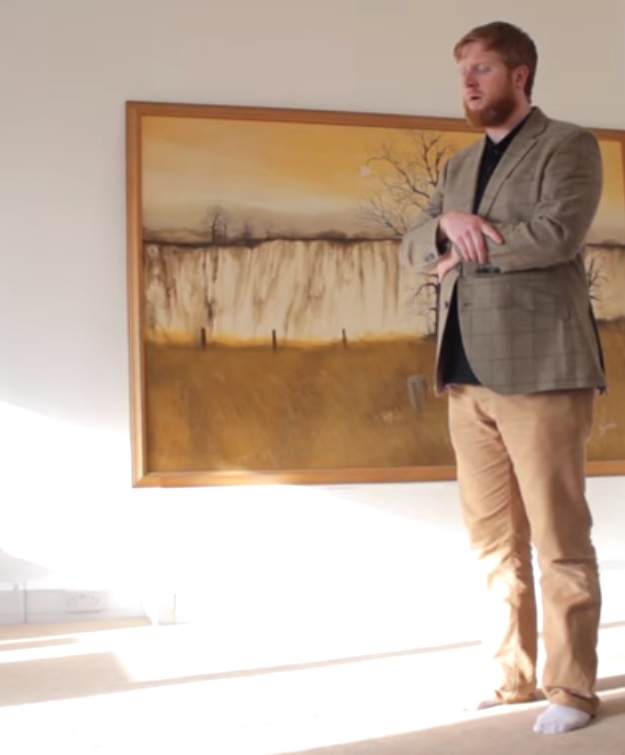
Source: OneReasonTV (https://www.youtube.com/watch?v=fZ4MEK7TFBo)
The correct position during a prayer. Also, note the distance between the feet
In addition to a healthy and physiological posture, there is also a distance between the feet of about 20 to 25 cm. This distance is required and corresponds to the distance between the two hip joints, the origins of both legs in the pelvis.

The correct (
This way, the center of gravity of the whole body is held in the middle between the legs and you feel so calm and steady when standing upright. But if you hold both feet closer to each other, which is wrong, then the center of gravity is shifted between one leg and the other leg, and then you have to constantly fight against falling down. On the other hand, if one keeps his two feet too far apart, this gives an unpleasant social impression. In addition, it is an awkward situation that is difficult to get out of the way. The reason for the requested distance between both feet is given anatomically, as the following picture shows.

An X-ray image of the human pelvis shows both hip joints, the beginnings of both legs with the clear distance in between [41]
And another thing: By bending both elbows, the large arteries of the arms bend in the area of these joints. This leads to a reflex to a mild increase in blood pressure. This is the first step to better blood flow to the various tissues and preheating and preparation for later stronger full-blood circulation.
4th: The Bowing (Ruku [42]):
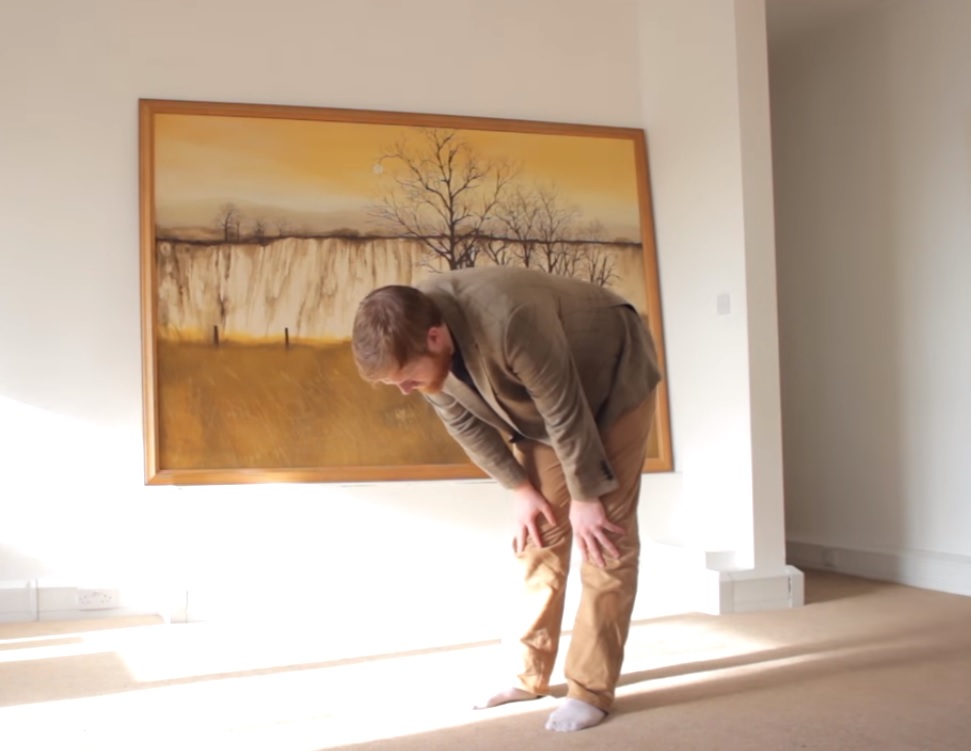
Source: OneReasonTV (https://www.youtube.com/watch?v=fZ4MEK7TFBo)
The right bow
The bowing is performed in the hip joint forward, while the spine is indeed kept straight and horizontal. So also the head is also kept horizontal. One should focus with the eyes on the place where he later shall put his forehead.

The right (
One supports oneself with the palmaren surface of the hands on the knees (kneecaps). Below is the anatomy of the pelvis with the two hip joints (shown in blue). You can see the distance between both hip joints apart.
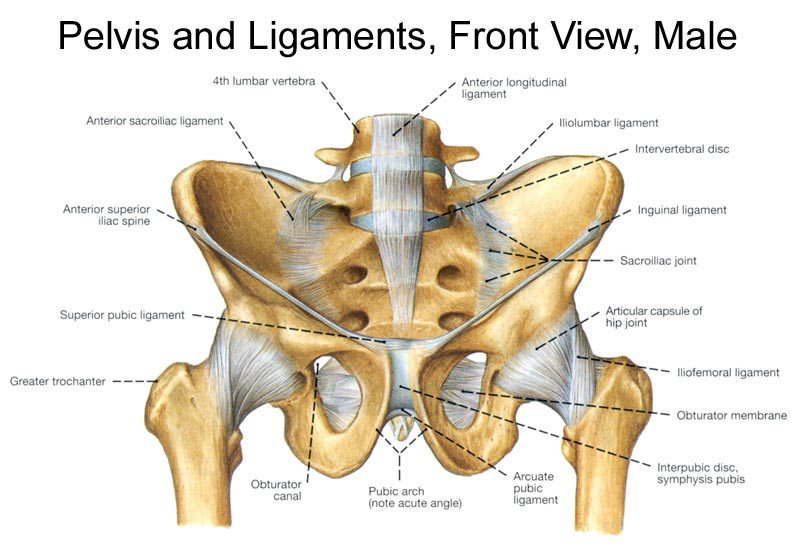
The hip joint (blue) connects the upper and lower pelvis [44]
In this final bow,

The right (√) and wrong (Χ) bow in prayer
as described above, there is first a mild stretch of both elbow joints (active) and both knees (passive), as well as to push both patella (kneecap) down the back. This is a so-called stretching exercise of the ligaments, which is very important for maintaining joint function. Passive or active stretching of the ligaments (ligament: bone-bone) and muscle-tendons (Tendon: bone-muscle) is one of the most important physiotherapeutic measures for the preservation and affirmation of the appropriate muscles and joints. This is also very good prevention against the stiffness of joints.
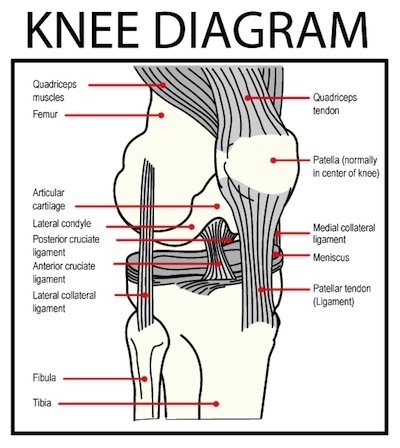
The inner and outer tendons of the knee [45]
This posture leads to a mild stretching, especially the lumbar spine, which leads to pain relief. Now that the head is at the same level of the heart, the blood flows much easier into the brain. In addition, due to the flexion in both larger hip joints and thus the buckling of the larger artery in their area, the blood pressure increases, which ensures proper blood supply to the brain cells. This step is indeed the second stage of a kind of preheating of a subsequent more active and powerful blood supply to the head. Furthermore, pushing both kneecaps back down ensures adequate blood supply to the patella and its appendages (quadriceps tendon and knee-ligament band). Because the blood reaches them only by diffusion from the environment. “Back-Down-Pressing” of the patellae facilitates and speeds up the mechanism of this type of blood supply. This protects the entire knee joint from premature degeneration.
This position (posture) simultaneously provides a slight passive stretching of the (specifically) lumbar spine. Yet, this stretching, since the vertebral joints are almost vertical, is sufficient for the reduction of the dislocations of those joints, which are occasionally dislocated by the constant load in daily life. This dislocation, even if it is only slight, spans the very sensitive joint capsule of the small vertebral joints and then leads to the annoying and disturbing back pain.

Back pain (Lumbalgia, Lumbago) [46]
By reducing this joint dislocation, the joint capsule relaxes again and the pain relieves significantly. Incidentally, the passive stretching of the spine is a well-recognized therapy method of back pain. That happens automatically in prayer, without us knowing it. Exactly the same situation is found in prostration (Sojud) when the entire spine is hung between the pelvis on the one hand, and the thighs and knees on the other, and the two shoulders on the other hand, which are carried by both arms.
The mentioned reduction is figuratively clarified as follows:

Lateral view of two lumbar vertebrae with the important vertebral joint (in the red circle) [47]
This lateral view shows two tangles articulating with each other through the so-called vertebral joints (in the red circle), which are almost vertical. Here, the “slight” gliding of the two articular processes occurs to each other (dislocation, or more precisely, subluxation) by the permanent everyday stress on the spine, which leads to the tension of the joint capsule. This in turn causes the well-known lumbalgia (back pain) and cervicalgia (neck pain). All vertebral joints together allow the large field of motion of the spine.
Fifth: The prostration (Sojud [48]):
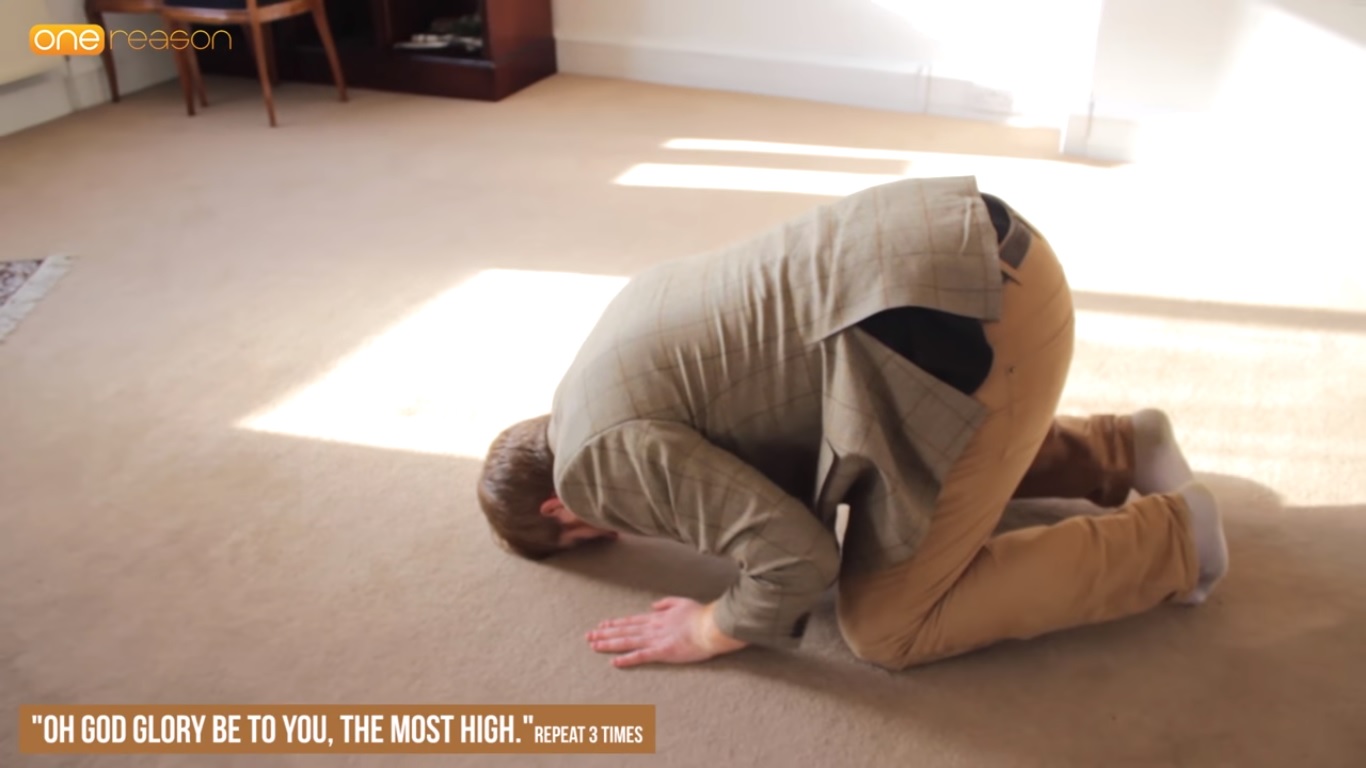
Source: OneReasonTV (https://www.youtube.com/watch?v=fZ4MEK7TFBo)
Because of what Muhammad, peace be upon him, said about prostration in prayer, during the prostration one should rest on seven bones. These 7 bones are:
The frontal and nasal bones of the face, (1st bone),
Both palms (2nd and 3rd bone),
Both knees (4th and 5th bones),
Toe tips of both feet (6th and 7th bones).
In this prostration position is:
►The head, and especially the forehead, is at the lowest point of the entire body.
►Both elbow joints are kinked.
►Both hip joints are also bent.
►Both knees are also bent.
Now we study this special (prostration) position:
There are large arteries in the area of both arms, both hip joints and in the area of both knees. Standing, they are now stretched. The heart beats normally, because there is no resistance in front of it. If a resistance stands before the heart, that is, the generator of blood pressure, it immediately and reflexively increases the pressure (the force with which the blood is pumped into the vessels); and that happens when the great artery kinks. Here we have six big arteries kinked. This narrows the diameter of the vessels at the kink, and thus increases the resistance to the activity of the heart in these vessels, resulting in a noticeable reflexive increase in blood pressure.
In the prostration, the head is lower than the heart. This is the first time the blood flows in mass to the direction of the head, without any help.
According to what is written above, by the additional increase of the blood pressure, the blood is now literally pumped into the head with pressure, especially into the frontal lobe of the brain, which is the area of thinking and making decisions. Surely, the smallest veins in the brain goes there too. Since two previous stages of preliminary preparation of the vessels had been carried out, this powerful pumping does not cause these smallest cerebral veins to burst. The two stages of preparation were: the first time, during standing, with only bending of both elbows; the second time, when bending, with the buckling of slightly larger arteries of both hip joints and bringing the head horizontally into the level of the heart. The third and more vigorous increase in blood pressure happens eventually in the case of prostration. The permanent repetition of this movement is the best vascular exercise for the whole circulatory system. So the vessels get stronger and more elastic walls over time and can not tear so easily, even at old age. It is therefore not only a true and practical type of prevention against the so-called arteriosclerosis (vascular calcification) but also against breakage and rupture of the blood vessels. The vessels retain their elasticity and strength and thus remain medically young. “A man is as old as his vessels and not like the number of years he has lived”, it is said!
More than optimal blood supply for the brain cells occurs in this position. This action of prostration repeats twice per rakaa (prayer unit) for each prayer. A prayer is known to consist of several units, and five complete prayers per day. So, it makes around 34 prostrations per day [49]. Prostration is a permanent, lifelong and effective exercise whose continuation is very important. I believe that there is no better blood supply to the brain cells and cells of other tissues than in Islamic prayer. This certainly provides, amongst the other things, a true and safe prevention against the so-called Alzheimer’s disease. The person in question always stays at his or her best mentally and physically fit situation throughout his life.
The next figure [50] shows the large arteries of the body and how they cross the various large joints.

And another remark: The large vessels usually branch only after passing the joint artery, so that when bending the joints, the main arteries and not their branches are kinked, which brings a greater effect.
This forced circulation brings benefits not only for the brain tissue, but actually for the entire body with all other organs. For example, the blood supply to the lungs has been briefly discussed here.
Not all lung blisters (alveoli), which is the place of gas exchange in the lungs, are open during normal everyday life. In the case of a stronger flow of blood through the lungs, additional alveoli open reflexively to load the entire amount of the incoming blood with oxygen (oxygenation). So the blood becomes more than 100% saturated during the prostration with oxygen (from the alveoli during the inhalation), which now brings greater benefits because the oxygenated blood is the elixir of life. Due to the oxygen supersaturation of the blood, the tissue is logically flooded with oxygen. This is very important for the proper functioning of the various cells of the different tissues and for the treatment of muscle pain caused by low-oxygen metabolism and the accumulation of lactic acid in muscle tissue (overstressing). An organ that is well supplied with blood heals very fast if injured, renews its dead cells soon, has a very good defense and stays active very well.
So, prostration (sojud!) is an indirect but very important factor in maintaining the “youth” of the various organs, and not least in combating the pain of all overworked muscles.
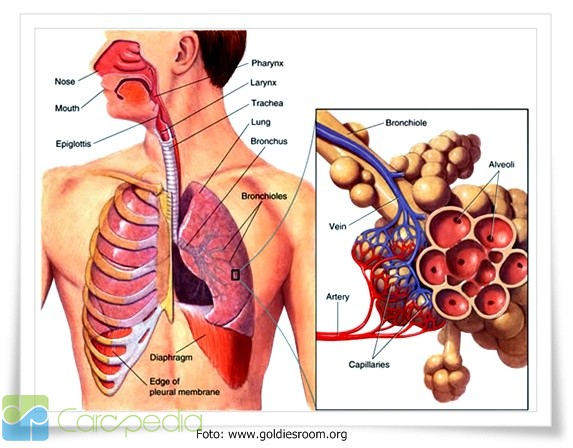
Figure [51] shows the lungs and especially the (right) alveoli enlarged.
It should be noted that the position of prostration also helps the entire spine to extend and stretch. This relieves their daily pain.
During the prostration and the resting of the face on the bones of the forehead and the nose, one supports oneself on both hands with the upper body inclined forward and downwards. When lifting, you push yourself up with both hands. All shoulder, chest and arm muscles are involved. This is similar to the sport of affirming the same muscles. There is also the stretching of the ligaments of the hand and toe joints. When sitting on the lower legs, the toe joints, but especially the upper hocks are stretched greatly. This relieves the pain and reinforces and increases their elasticity for permanent proper function. Interestingly enough, all of this happens without us registering or thinking about it.
So: Prostration supports and strengthens the heart and improves the quality of the whole circuit for the whole life. When the face is placed directly on the earth, the whole body is de-electrified (released) from the electrical charge surplus. The human body stores many electrical charges over a period of time, which is disturbing.
Praying in Islam trains and strengthens almost all joints and muscles of the body, and relieves their pain directly and indirectly.
Bending and Stretching the Joints During Prayer
Active and voluntary flexion and extension of the joints in prayer, for several times during the day and the whole life, are very much desired exercises to strengthen the muscles and maintain the elastic functions of the joints. This protects all joints from premature degeneration and other diseases, because every disease of every joint restricts, or later even prevents, the movements. These prayer movements are simultaneously an automatic treatment and effective prevention.
We should also mention that during an active and voluntary flexion or extension of a joint, the opposing antagonistic muscles are passively stretched or flexed respectively. Stretching or shortening, whether active or passive, affects the ligaments of the joints and tendons (tendon) of the muscles and keeps them fully functional, because these parts of the movement system do not have their own blood vessels and are dependent on the diffusion of the blood supply in their neighborhood. Active and passive training supports the mechanism of diffusion of these parts, improving their blood supply.
We already know what ligament means. And now let’s define what tendon is. In the following picture [52] both terms are made clear:
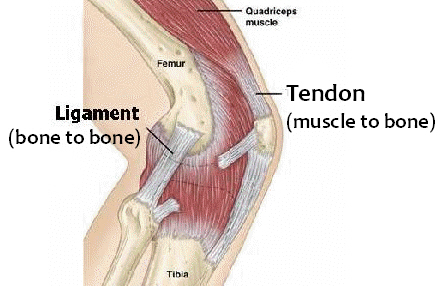
Lowering and Raising
When you go from standing to the prostration position in prayer, you have to lower yourself. From sitting in the standing position you have to lift yourself up. This low and high walking, which is mainly done by the quadriceps muscle and with the help of the gluteal (buttocks) and abdominal muscles, is a not such an easy physical exercise. This is a very stimulating and reassuring exercise of related muscles, especially the quadriceps, the all-important muscle of the body. This muscle is responsible for human stability when standing, running, or climbing stairs.
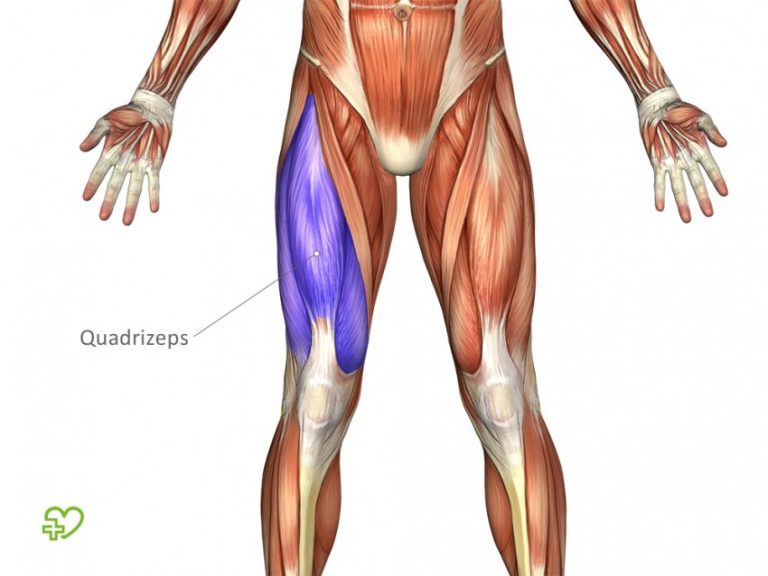
Quadriceps of the front thigh [53]
In prayer, the best exercise of the quadriceps and exercise of all other leg muscles is done, so they are always ready to use. In the field of physiotherapy, this muscle is specially trained with the help of equipment, as shown in the following figure:

Quadriceps training with the help of special equipment [54]
So if you have a powerful quadriceps, you can stay active throughout your life and are always able to serve yourself without any help from others, even in high old age. Isn’t it nice?
Sixth: The End of the Prayer
And now we come to the last section in Islamic prayer, namely the announcement of the end of the prayer, where one turns the head once to the right, then to the left side while sitting and says: “Assalamu Alaykum (May peace be upon you)”. Now the prayer is finished.

The completion of the prayer by turning the head first to the right (left picture), then to the left (right picture) [55]
This ritual movement of the head to the right and then to the left is a good physiotherapy-recommended exercise for the cervical spine, especially when repeated several times a day to train the various and complex vertebral ligaments and tendons of the neck and shoulder muscles in order to maintain their functional efficiency.

The cervical spine [56]
Of course, at the same time all muscles involved in the movement of the neck are trained and confirmed:

The musculature of the neck region [57]
And certainly, GOD knows better and more accurately!
Prof. Dr. Abdulhamid Gehani (May he rest in peace /Rahimahullah)
Istanbul
25.01.2018
REFERENCES
[1] Alzheimer’s disease (after Alois Alzheimer, Germany.) Is a disease that affects the nerve cells of the brain, especially the ability to think and think, in old age, where they regress and their function is lost.
[2] These are the symptoms of brain cell atrophy (Alzheimer’s disease)
[4]https://www.google.com.tr/search?q=greisenalter+definition&rlz=1C1CHZL_trTR701TR701&source=lnms&tbm=isch&sa=X&ved=0ahUKEwjDh7uZrNLYAhUEIJoKHe07BJcQ_AUICigB&biw=1340&bih=622
[5] Rudi Paret
[7] https://de.wikihow.com/Beten-im-Islam
[8]Rudi Paret
[9]Rudi Paret, gebessert.
[10] Ahmadeyya
[11] Qiblah: This is the direction towards which all Muslims offer their prayers, namely Kabah in Mecca, Saudi Arabia.
[12] 2004 Al Bawab (www.albawab.com)
[13] Rudi Paret
[14] Qiblah heißt die Richtung nach Mekka
[15]https://www.google.com.tr/search?q=kaba&rlz=1C1CHZL_trTR701TR701&tbm=isch&tbo=u&source=univ&sa=X&ved=0ahUKEwifzJ6Ih9LYAhWBZpoKHSe_ArYQsAQIPA&biw=1340&bih=622#imgrc=RcwzwIqbQJm9DM:
[16] Bakka is another name for Mecca.
[17] Rudi Paret
[18] Rudi Paret
[19]/www.google.com.tr/search?q=schwarzer+stein+mekka&rlz=1C1CHZL_trTR701TR701&source=lnms&tbm=isch&sa=X&ved=0ahUKEwim9If_jNLYAhXEHpoKHXyEDSUQ_AUICigB&biw=1340&bih=622#imgrc=1CUdO51Q1B-BUM:
[20] Suleymaniye Foundation English Translation
[21] Suleymaniye Foundation English Translation
[22] Suleymaniye Foundation English Translation
[23] Bakka is another name for Mecca.
[24] Suleymaniye Foundation English Translation
[25] Suleymaniye Foundation English Translation
[26] Suleymaniye Foundation English Translation
[27] Suleymaniye Foundation English Translation
[28]https://www.google.co.in/search?biw=1024&bih=677&tbm=isch&sa=1&btnG=Search&q=electromagnetic+field+of+heart+and+mind#imgrc=
[30]https://www.google.com.tr/search?q=magnetisches+feld+der+erde&rlz=1C1CHZL_trTR701TR701&source=lnms&tbm=isch&sa=X&ved=0ahUKEwjW0OzWo8rYAhWpNJoKHUpOB_QQ_AUICigB&biw=1340
[30]https://www.google.com.tr/search?q=magnetisches+feld+der+erde&rlz=1C1CHZL_trTR701TR701&s &bih=622
[31] Polarization (making two poles) means that all negative charges in a cell are accumulated on one side, whereas all the positive charges accumulate on the opposite side.
[32]/www.google.com.tr/search?q=elektrische+Ladung+der+Zelle&sa=X&rlz=1C1CHZL_trTR701TR701&tbm=isch&tbo=u&source=univ&ved=0ahUKEwiFt_PgjKzYAhWB
[33]/www.google.com.tr/search?q=elektrische+Ladung+der+Zelle&sa=X&rlz=1C1CHZL_trTR701TR701&tbm=isch&tbo=u&source=univ&ved=0ahUKEwiFt_PgjKzYAhWB
[34]/www.google.com.tr/search?q=elektrische+Ladung+der+Zelle&sa=X&rlz=1C1CHZL_trTR701TR701&tbm=isch&tbo=u&source=univ&ved=0ahUKEwiFt_PgjKzYAhWB
[35]www.google.com.tr/search?q=eisen+und+magnetismus&rlz=1C1CHZL_trTR701TR701&source=lnms&tbm=isch&sa=X&ved=0ahUKEwjo8qjgpcrYAhUEQZoKHTBXAXIQ_AUICigB&biw=1340&bih=622#imgrc=AxiZZlEG79QlrM:
[36] http://www.alamy.com/stock-photo-bar-magnet-showing-magnetic-field-w-iron-filings-12689619.html
[37] Suleymaniye Foundation English Translation
[38]/www.google.com.tr/search?q=تكبيرة+الاحرام&rlz=1C1CHZL_trTR701TR701&source=lnms&tbm=isch&sa=X&ved=0ahUKEwiHzsWi-u_YAhXmIMAKHTxjDNkQ_AUICigB&biw=1338&bih=620
[39]/www.google.com.tr/search?q=schulter+muskeln&rlz=1C1CHZL_trTR701TR701&source=lnms&tbm=isch&sa=X&ved=0ahUKEwjgmJOkh_DYAhUmhqYKHXunATQQ_AUICigB&biw=1338&bih=620#imgdii=KXoq-m6iidDl8M:&imgrc=DJ9laziHLkR-NM:
[40] https://de.wikihow.com/Beten-im-Islam
[41]//www.google.com.tr/search?q=rontgen+pelvis+normal&rlz=1C1CHZL_trTR701TR701&source=lnms&tbm=isch&sa=X&ved=0ahUKEwjEmfKl1vDYAhUBWywKHTIvA7QQ_AUICigB&biw=1338&bih=620#imgdii=SoCKlD5tnWBiGM:&imgrc=YQOV8nyjH36WLM:
[42] Roku is the Arabic name for bowing
[43]//www.google.com.tr/search? q=niederwerfung+im+gebet&rlz=1C1CHZL_trTR701TR701&source=lnms&tbm=isch&sa=X&ved=0ahUKEwic16jmut7YAhULDywKHQHNAWIQ_AUICigB&biw=1340&bih=622#imgrc=TuK7Wsovbd1TSM:
[44]//www.google.com.tr/search?q=anatomie+des+männlichen+beckens&rlz=1C1CHZL_trTR701TR701&source=lnms&tbm=isch&sa=X&ved=0ahUKEwjT4NmY2vDYAhUJjiwKHVnhDOYQ_AUICigB&biw=1338&bih=620#imgdii=qBjtKxO7IAl3gM:&imgrc=JYPIhXweTzbfLM:
[45]/www.google.com.tr/search?q=bände+und+ligamente&rlz=1C1CHZL_trTR701TR701&source=lnms&tbm=isch&sa=X&ved=0ahUKEwiJyu7-9uXYAhWPCewKHeneCYkQ_AUICigB&biw=1340&bih=622#imgdii=fAuCZA9FXjiuEM:&imgrc=YmPY1Rn246NB4M:
[46]www.google.com.tr/search?q=rückenschmerzen&tbm=isch&tbs=rimg:CU6Id9AKDmizIjg5dcx8xJ3ZJ4265v01quAPyIPzxW3FenwBTuTs3wZyPF_1WPTQcxcup5GpF8upajWO90HOwOHy-_1ioSCTl1zHzEndknEUqpzsvlFiO_1KhIJjbrm_1TWq4A8RRemHAYc-fTgqEgnIg_1PFbcV6fBHQLd4vJqi5_1SoSCQFO5OzfBnI8ES8Zter_1hl_1aKhIJX9Y9NBzFy6kRQCSXAZc9dX8qEgnkakXy6lqNYxFpTH0Rx2nBlSoSCb3Qc7A4fL7-EVg5jw029dLF&tbo=u&sa=X&ved=0ahUKEwini9n3-erYAhUI56QKHb-NCMwQ9C8IHw&biw=1338&bih=620&dpr=1#imgrc=yIPzxW3Fenwt_M:
[47]www.google.com.tr/search?q=wirbelsäule+aufbau&rlz=1C1CHZL_trTR701TR701&tbm=isch&tbo=u&source=univ&sa=X&ved=0ahUKEwiRp5288NvYAhVJWywKHV43CJ8QsAQIJw&biw=1340&bih=622#imgrc=zOR1RIT2pF6YCM:
[48] Sojud is the Arabic name for prostration. It is the plural form of ‘sajda’.
[49] Sajda is a single instance of prostration
[50]/www.google.com.tr/search?q=die+großen+Schlagader&rlz=1C1CHZL_–lnms&tbm=isch&sa=X&ved=0ahUKEwio1rit1tzYAhWIBywKHbZCDusQ_AUICigB&biw=1340&bih=622#imgrc=azPzH9qBGjdZmM:
[51] http:// images.slideplayer.org/33/10203146/slides/slide_25.jpg
[52]//www.google.com.tr/search?q=ligamente&rlz=1C1CHZL_trTR701TR701&source=lnms&tbm=isch&sa=X&ved=0ahUKEwiiodj8nOvYAhUth6YKHagWDe8Q_AUICigB&biw=1338&bih=620#imgrc=b8YviDlbYmYacM:
[53]/www.google.com.tr/search?q=quadriceps+anatomie&rlz=1C1CHZL_trTR701TR701&tbm=isch&tbo=u&source=univ&sa=X&ved=0ahUKEwjgrrS13evYAhUKVSwKHaMNALMQsAQIJw&biw=1338&bih=620#imgrc=saxRsWbI_9N4BM:
[54]www.google.com.tr/search?q=quadriceps+training&rlz=1C1CHZL_trTR701TR701&tbm=isch&tbo=u&source=univ&sa=X&ved=0ahUKEwjWs_zp1OvYAhUBlSwKHSXgAPIQsAQIQw&biw=1338&bih=620#imgrc=hQMm_J93GkQnzM
[55]https://www.google.com.tr/search?q=beten+islam&rlz=1C1CHZL_trTR701TR701&source=lnms&tbm=isch&sa=X&ved=0ahUKEwi37eOP0u3YAhXBjywKHQ94CdQQ_AUICigB&biw=1338&bih=620#imgrc=GDYySHLMYTk4iM:
[56]://www.google.com.tr/search?q=zervikale+Wirbelsäule&rlz=1C1CHZL_trTR701TR701&tbm=isch&tbo=u&source=univ&sa=X&ved=0ahUKEwispuWtzu3YAhUCEiwKHcNDAvoQsAQIOg&biw=1338&bih=620#imgrc=FG2IYLOXMXkf4M:
[57]/www.google.com.tr/search?q=zervikale+Wirbelsäule&rlz=1C1CHZL_trTR701TR701&tbm=isch&tbo=u&source=univ&sa=X&ved=0ahUKEwispuWtzu3YAhUCEiwKHcNDAvoQsAQIOg&biw=1338&bih=620#imgdii=uOP356tB-5oe3M:&imgrc=9yaWNol5BFDtOM:



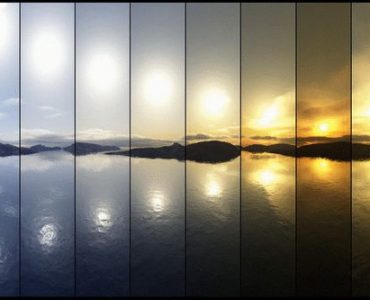


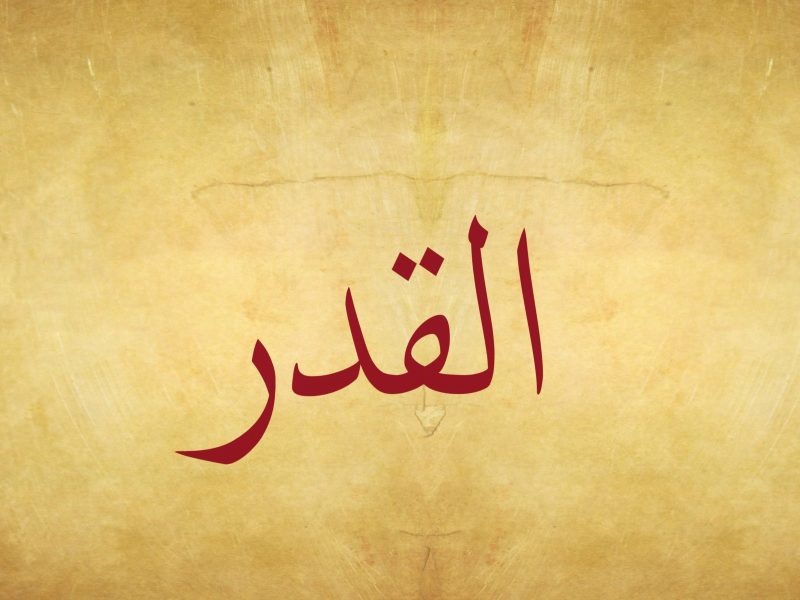

Add comment